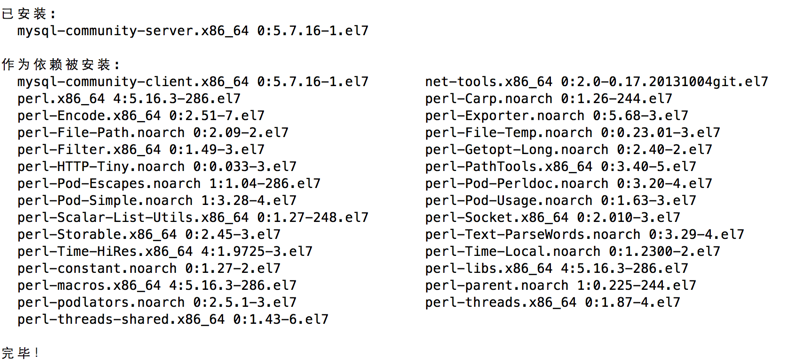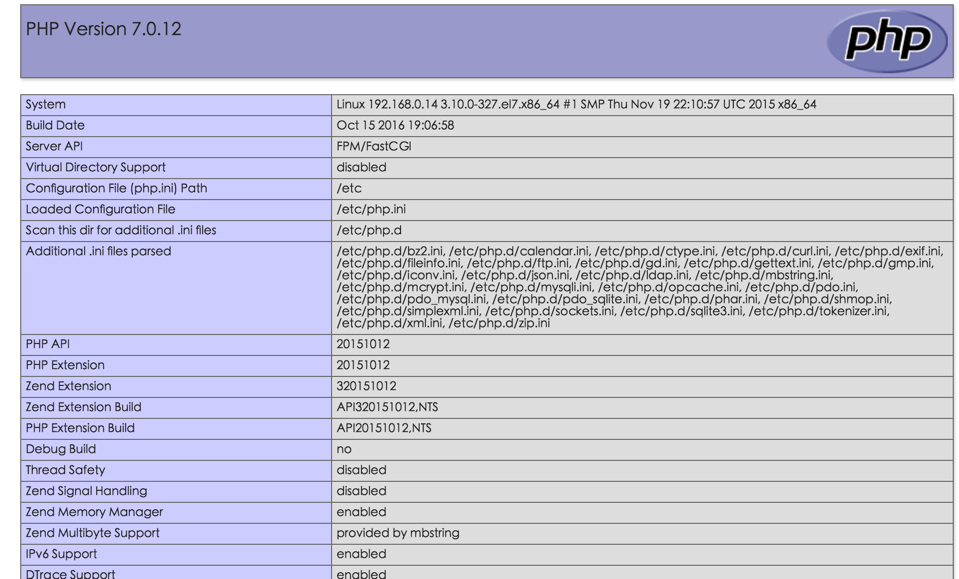用centos自带的yum源来安装nginx,mysql和php,超级方便,省去编译的麻烦,省去自己配置的麻烦,还能节省非常多的时间。
我们先把yum源换成国内的阿里云镜像源(当然不换也可以),先备份一下原来的源镜像文件,以免出错后可以恢复:
[root@192 ~]# mv /etc/yum.repos.d/CentOS-Base.repo /etc/yum.repos.d/CentOS-Base.repo.backup
下载新的CentOS-Base.repo 到/etc/yum.repos.d/,版本根据自己的系统版本选择下载:

CentOS 5 wget -O /etc/yum.repos.d/CentOS-Base.repo http://mirrors.aliyun.com/repo/Centos-5.repo
CentOS 6 wget -O /etc/yum.repos.d/CentOS-Base.repo http://mirrors.aliyun.com/repo/Centos-6.repo
CentOS 7 wget -O /etc/yum.repos.d/CentOS-Base.repo http://mirrors.aliyun.com/repo/Centos-7.repo

更改/etc/yum.repos.d/CentOS-Media.repo使其为不生效:
enabled=0
运行yum makecache生成缓存:
yum clean all yum makecache yum update
安装Nginx
由于yum源中没有我们想要的nginx,那么我们就需要创建一个“/etc/yum.repos.d/nginx.repo”的文件,其实就是新增一个yum源。
[root@192 yum.repos.d]# vi /etc/yum.repos.d/nginx.repo
把如下内容复制进去:
[nginx] name=nginx repo baseurl=http://nginx.org/packages/centos/$releasever/$basearch/ gpgcheck=0 enabled=1
然后保存退出,输入 yum list nginx 查看,

[root@192 yum.repos.d]# yum list nginx
已加载插件:fastestmirror
nginx | 2.9 kB 00:00:00
nginx/7/x86_64/primary_db | 18 kB 00:00:04
Loading mirror speeds from cached hostfile
* base: mirrors.aliyun.com
* extras: mirrors.aliyun.com
* updates: mirrors.aliyun.com
可安装的软件包
nginx.x86_64 1:1.10.2-1.el7.ngx nginx
[root@192 yum.repos.d]# yum list |grep nginx
nginx.x86_64 1:1.10.2-1.el7.ngx nginx
nginx-debug.x86_64 1:1.8.0-1.el7.ngx nginx
nginx-debuginfo.x86_64 1:1.10.2-1.el7.ngx nginx
nginx-module-geoip.x86_64 1:1.10.2-1.el7.ngx nginx
nginx-module-geoip-debuginfo.x86_64 1:1.10.2-1.el7.ngx nginx
nginx-module-image-filter.x86_64 1:1.10.2-1.el7.ngx nginx
nginx-module-image-filter-debuginfo.x86_64 1:1.10.2-1.el7.ngx nginx
nginx-module-njs.x86_64 1:1.10.2.0.0.20160414.1c50334fbea6-2.el7.ngx
nginx
nginx-module-njs-debuginfo.x86_64 1:1.10.2.0.0.20160414.1c50334fbea6-2.el7.ngx
nginx
nginx-module-perl.x86_64 1:1.10.2-1.el7.ngx nginx
nginx-module-perl-debuginfo.x86_64 1:1.10.2-1.el7.ngx nginx
nginx-module-xslt.x86_64 1:1.10.2-1.el7.ngx nginx
nginx-module-xslt-debuginfo.x86_64 1:1.10.2-1.el7.ngx nginx
nginx-nr-agent.noarch 2.0.0-10.el7.ngx nginx
pcp-pmda-nginx.x86_64 3.10.6-2.el7 base
[root@192 yum.repos.d]#

如果执行命令是这样的显示效果,那么我们的nginx的yum源就配置成功啦!
然后要安装我们的nginx就直接执行:
yum -y install nginx
这样nginx的最新官网版本就安装好了!
启动nginx:

# nginx #启动nginx
curl 127.0.0.1
Welcome to nginx!
If you see this page, the nginx web server is successfully installed and working. Further configuration is required.
For online documentation and support please refer to
nginx.org.
Commercial support is available at
nginx.com.
Thank you for using nginx.

安装MySQL 5.7版本,官网http://dev.mysql.com/downloads/repo/yum/
rpm -Uvh http://dev.mysql.com/get/mysql57-community-release-el7-9.noarch.rpm
可以看到已经有了,并且5.7版本已经启用,可以直接安装:

root@192 yum.repos.d]# yum repolist all | grep mysql mysql-connectors-community/x86_64 MySQL Connectors Community 启用: 24 mysql-connectors-community-source MySQL Connectors Community - Sourc 禁用 mysql-tools-community/x86_64 MySQL Tools Community 启用: 38 mysql-tools-community-source MySQL Tools Community - Source 禁用 mysql-tools-preview/x86_64 MySQL Tools Preview 禁用 mysql-tools-preview-source MySQL Tools Preview - Source 禁用 mysql55-community/x86_64 MySQL 5.5 Community Server 禁用 mysql55-community-source MySQL 5.5 Community Server - Sourc 禁用 mysql56-community/x86_64 MySQL 5.6 Community Server 禁用 mysql56-community-source MySQL 5.6 Community Server - Sourc 禁用 mysql57-community/x86_64 MySQL 5.7 Community Server 启用: 146 mysql57-community-source MySQL 5.7 Community Server - Sourc 禁用 mysql80-community/x86_64 MySQL 8.0 Community Server 禁用 mysql80-community-source MySQL 8.0 Community Server - Sourc 禁用 [root@192 yum.repos.d]#

如果没有开启,或者你想要选择需要的版本进行安装,修改 /etc/yum.repos.d/mysql-community.repo,选择需要的版本把enable改为1即可,其它的改为0:

修改好后查看可用的安装版本:
[root@192 yum.repos.d]# yum repolist enabled | grep mysql mysql-connectors-community/x86_64 MySQL Connectors Community 24 mysql-tools-community/x86_64 MySQL Tools Community 38 mysql57-community/x86_64 MySQL 5.7 Community Server 146
不用犹豫,开始安装吧!
yum -y install mysql-community-server
……经过漫长的等待后,看到下图所示:

开始启动mysql:
service mysqld start Redirecting to /bin/systemctl start mysqld.service
看下mysql的启动状态:

[root@192 yum.repos.d]# service mysqld status Redirecting to /bin/systemctl status mysqld.service ● mysqld.service - MySQL Server Loaded: loaded (/usr/lib/systemd/system/mysqld.service; enabled; vendor preset: disabled) Active: active (running) since 日 2016-10-23 22:51:48 CST; 3min 14s ago Process: 36884 ExecStart=/usr/sbin/mysqld --daemonize --pid-file=/var/run/mysqld/mysqld.pid $MYSQLD_OPTS (code=exited, status=0/SUCCESS) Process: 36810 ExecStartPre=/usr/bin/mysqld_pre_systemd (code=exited, status=0/SUCCESS) Main PID: 36887 (mysqld) CGroup: /system.slice/mysqld.service └─36887 /usr/sbin/mysqld --daemonize --pid-file=/var/run/mysqld/mysqld.pid
10月 23 22:51:45 192.168.0.14 systemd[1]: Starting MySQL Server... 10月 23 22:51:48 192.168.0.14 systemd[1]: Started MySQL Server. 10月 23 22:52:24 192.168.0.14 systemd[1]: Started MySQL Server.

开机启动设置:
systemctl enable mysqld systemctl daemon-reload
mysql安装完成之后,在/var/log/mysqld.log文件中给root生成了一个默认密码。通过下面的方式找到root默认密码,然后登录mysql进行修改:
[root@192 yum.repos.d]# grep 'temporary password' /var/log/mysqld.log 2016-10-23T14:51:45.705458Z 1 [Note] A temporary password is generated for root@localhost: a&sqr7dou7N_ mysql -uroot -p
修改root密码:
ALTER USER 'root'@'localhost' IDENTIFIED BY 'NewPassWord!';
注意:mysql5.7默认安装了密码安全检查插件,默认密码检查策略要求密码必须包含:大小写字母、数字和特殊符号,并且长度不能少于8位。否则会提示ERROR 1819 (HY000): Your password does not satisfy the current policy requirements错误,如下图所示:

通过msyql环境变量可以查看密码策略的相关信息:

mysql> show variables like '%password%'; +---------------------------------------+--------+ | Variable_name | Value | +---------------------------------------+--------+ | default_password_lifetime | 0 | | disconnect_on_expired_password | ON | | log_builtin_as_identified_by_password | OFF | | mysql_native_password_proxy_users | OFF | | old_passwords | 0 | | report_password | | | sha256_password_proxy_users | OFF | | validate_password_check_user_name | OFF | | validate_password_dictionary_file | | | validate_password_length | 8 | | validate_password_mixed_case_count | 1 | | validate_password_number_count | 1 | | validate_password_policy | MEDIUM | | validate_password_special_char_count | 1 | +---------------------------------------+--------+ 14 rows in set (0.00 sec)

validate_password_policy:密码策略,默认为MEDIUM策略
validate_password_dictionary_file:密码策略文件,策略为STRONG才需要
validate_password_length:密码最少长度
validate_password_mixed_case_count:大小写字符长度,至少1个
validate_password_number_count :数字至少1个
validate_password_special_char_count:特殊字符至少1个
上述参数是默认策略MEDIUM的密码检查规则。
修改密码策略
如果想修改密码策略,在/etc/my.cnf文件添加validate_password_policy配置:
# 选择0(LOW),1(MEDIUM),2(STRONG)其中一种,选择2需要提供密码字典文件 validate_password_policy=0
配置默认编码为utf8
修改/etc/my.cnf配置文件,在[mysqld]下添加编码配置,如下所示:
[mysqld] character_set_server=utf8 init_connect='SET NAMES utf8'
重新启动mysql服务使配置生效:
systemctl restart mysqld
添加远程登录用户
默认只允许root帐户在本地登录,如果要在其它机器上连接mysql,必须修改root允许远程连接,或者添加一个允许远程连接的帐户,为了安全起见,我们添加一个新的帐户:
mysql> GRANT ALL PRIVILEGES ON *.* TO 'evai'@'%' IDENTIFIED BY '@evai2016' WITH GRANT OPTION;
mysql> FLUSH PRIVILEGES;
这样远程就可以用账户名为evai,密码为@evai2016来登录数据库了,运行 select host, user from mysql.user 查看下:

mysql> select host,user from mysql.user; +-----------+-----------+ | host | user | +-----------+-----------+ | % | evai | | localhost | mysql.sys | | localhost | root | +-----------+-----------+ 3 rows in set (0.00 sec)

安装PHP7
rpm -Uvh https://dl.fedoraproject.org/pub/epel/epel-release-latest-7.noarch.rpm rpm -Uvh https://mirror.webtatic.com/yum/el7/webtatic-release.rpm
执行命令安装php7:
yum install php70w.x86_64 php70w-cli.x86_64 php70w-common.x86_64 php70w-gd.x86_64 php70w-ldap.x86_64 php70w-mbstring.x86_64 php70w-mcrypt.x86_64 php70w-mysql.x86_64 php70w-pdo.x86_64
安装php-fpm:
yum install php70w-fpm php70w-opcache
启动php-fpm:
systemctl start php-fpm
修改 /etc/nginx/conf.d/default.conf 文件,找到下面这段并改为如下所示:

location ~ \.php$ { root /usr/share/nginx/html; fastcgi_pass 127.0.0.1:9000; fastcgi_index index.php; fastcgi_param SCRIPT_FILENAME $document_root$fastcgi_script_name; include fastcgi_params; }

接着到 /usr/share/nginx/html 目录下创建一个test.php文件,内容为phpinfo():
vi /usr/share/nginx/html/test.php
#内容 <?php phpinfo();
保存退出。接着重启nginx:
nginx -s reload
打开浏览器,看到如下图说明运行成功:

至此环境搭建完成。













